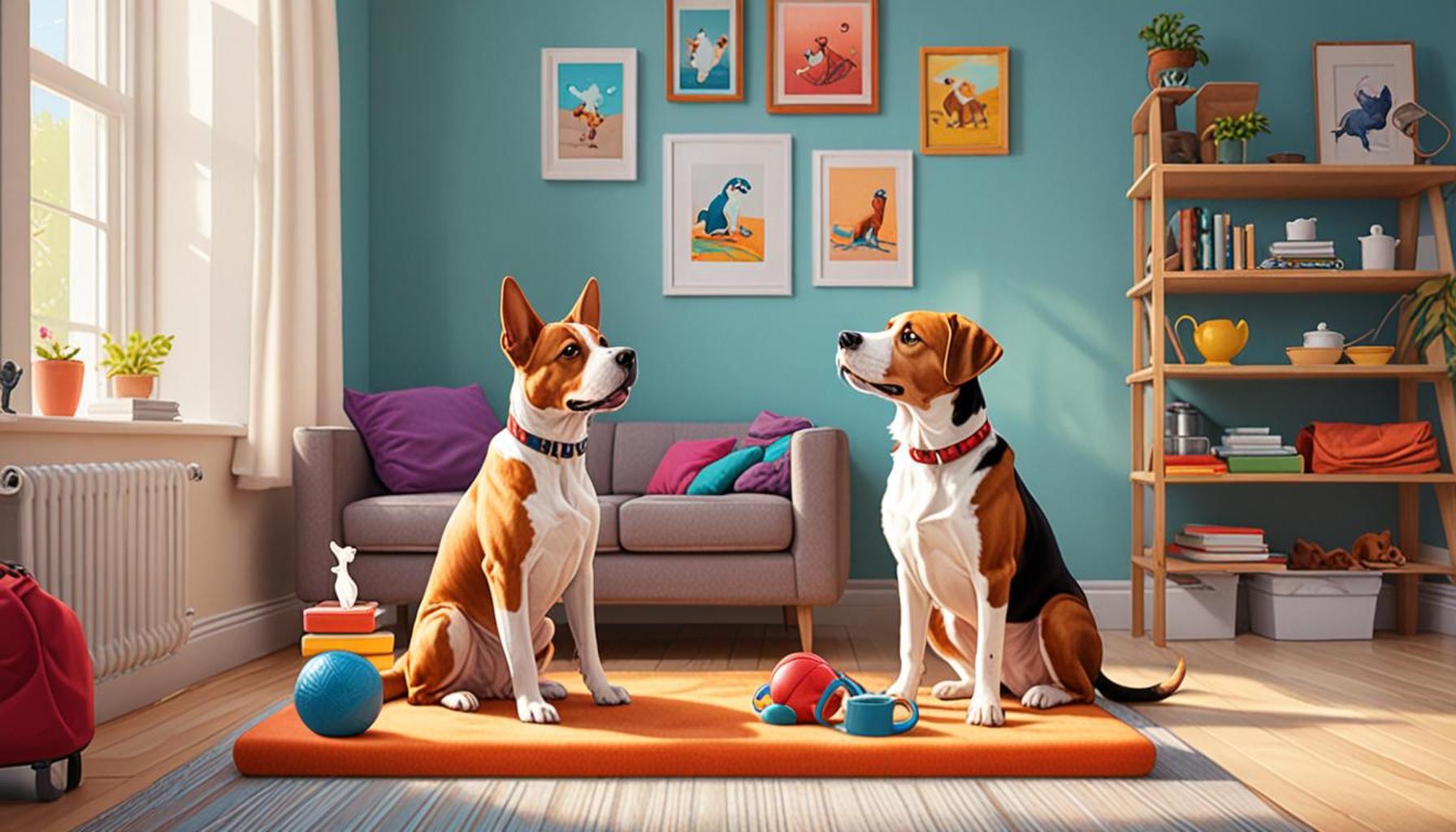Incorporating Obedience Training into Daily Activities for a Well-Behaved Pet

Utilizing Daily Activities for Behavioral Improvement in Pets
Every pet parent dreams of a well-behaved furry companion. Obedience training can play a pivotal role in achieving this goal. The good news? You don’t need to set aside hours for training. Instead, you can incorporate small, effective techniques into your daily activities that foster a positive learning environment for your pet.
A major advantage of integrating training into daily routines is that it creates a natural learning opportunity for your pet. Here are some practical approaches that can make a significant impact:
- Morning Routines: Morning can be an ideal time to reinforce commands. For instance, during meal times, you can ask your pet to “sit” before placing their food bowl down. This not only teaches them to respond to commands but also builds patience. You could also introduce the “stay” command while you prepare breakfast, further enhancing their self-control.
- Walks: Daily walks are not just a way for your pet to stretch their legs; they present a perfect opportunity for teaching useful commands. Practice leash training by teaching your pet to walk nicely beside you. Incorporate commands like “stop” or “wait” when you approach a street corner, instilling a sense of traffic safety. This not only keeps them safer but also enforces their obedience in a real-world context.
- Play Time: Games can serve as a powerful training tool. Instead of simple fetch, introduce variations that require your pet to respond to cues. For example, you can call out “come” or “drop it” during play to reinforce these commands. Engaging in interactive play also enhances listening skills while allowing for vital exercise, making it both fun and beneficial.
These methods not only make training enjoyable but also strengthen the bond between you and your pet. Research shows that regular training can lead to better obedience and fewer behavioral issues. For instance, a study published in the Journal of Veterinary Behavior found that pets who received consistent training were less likely to engage in destructive behaviors, such as chewing furniture or excessive barking.
With commitment and creativity, you can seamlessly weave obedience training into your everyday life. Remember that the journey to a better-behaved pet begins with small, consistent efforts. Whether you’re a seasoned pet owner or a newcomer, these interactive approaches will not only facilitate your pet’s learning but also enrich your shared experience, ultimately leading to a more harmonious home.
DISCOVER MORE: Click here to learn how agility training can benefit your pet

Maximizing Everyday Moments for Training Opportunities
Incorporating obedience training into daily activities not only reinforces good behavior but also transforms mundane routines into engaging learning sessions for your pet. By seizing everyday moments, you can make training a consistent and enjoyable part of your pet’s life. Here are additional strategies that can enhance your efforts:
- Grooming Sessions: Regular grooming goes beyond maintaining your pet’s physical appearance; it can serve as an excellent training opportunity. During grooming, you can teach your pet to “stay” or “lie down” while you brush or trim their fur. This not only promotes calmness during grooming but also reinforces the bond between you and your pet. For instance, if you have a dog, using the “stay” command while you trim their nails helps them associate grooming with positive experiences. Moreover, introducing tasks such as checking their ears or brushing their teeth can familiarize them with necessary care routines, ensuring they remain relaxed in future grooming scenarios. By making these activities habitual, you are not only caring for your pet’s hygiene but also instilling discipline and trust.
- Bedtime Rituals: Establishing a bedtime routine can also double as training time. As you prepare to settle down for the night, encourage your pet to “go to bed” by guiding them to their designated sleeping area. To solidify this behavior, reward them with a treat and some affection for following the command. This practice reinforces their understanding of boundaries and helps them internalize where they should sleep. Over time, this contributes to a peaceful nighttime environment, fostering security for both you and your pet. Consider adding a few relaxing commands like “settle” or “quiet” during this time to further enhance their calmness.
- Visitors and Socialization: When guests arrive at your home, it’s an ideal opportunity to implement obedience training. Teach your pet to greet visitors calmly by asking them to “sit” or “stay” before approaching. This not only reinforces good manners but also helps your pet learn how to behave around new people. Additionally, practical commands such as “leave it” can prevent your pet from jumping at guests or becoming overly excited. Training in social settings delineates boundaries, helping your pet to distinguish between appropriate and inappropriate behaviors. To enhance this experience, consider giving treats to both your pet and the guests for positive reinforcement when your pet behaves appropriately.
Furthermore, research supports the benefits of integrating training into your daily activities. A survey conducted by the American Society for the Prevention of Cruelty to Animals (ASPCA) found that pets who engage in regular, short training sessions tend to exhibit fewer behavioral problems. This reinforces the idea that consistent behavioral reinforcement can lead to a happier, well-adjusted pet.
Incorporating obedience training into your daily routine doesn’t have to be an overwhelming commitment. With a few structured yet simple approaches, you can seamlessly blend training into your lifestyle. Setting small, achievable goals—like practicing one command per day—can yield significant progress over time. Celebrating your pet’s advancements promotes a sense of achievement, solidifying the relationship you share. By championing these nurturing training efforts, you’ll be paving the way for a respectful bond characterized by mutual understanding, ultimately enhancing the harmony within your home.
| Advantage | Details |
|---|---|
| Enhanced Communication | Incorporating training into daily routines fosters clear communication between pet and owner, enriching the bond. |
| Improved Behavior | Regular behavior reinforcement leads to less anxiety and more socially acceptable behaviors in diverse environments. |
| Increased Confidence | Obedience training during daily activities builds a pet’s confidence, enabling them to handle new situations. |
| Stronger Bond | Involving your pet in training enhances mutual respect and trust, leading to a healthier relationship. |
Incorporating obedience training into daily activities not only promotes a well-behaved pet but also can significantly enhance the overall dynamics between you and your furry companion. Whether it’s teaching basic commands during leisurely walks or reinforcing good behavior while out shopping, the application of training becomes an invaluable tool. By establishing routines, you create a structure that pets thrive under, allowing them to feel more secure and engaged. From teaching basic commands to fine-tuning signals that encourage good behavior, these interactions can greatly reduce behavioral issues. Moreover, the repetitive nature of incorporating training seamlessly into everyday moments ensures that your pet retains their skills while enjoying the activities they love most. As you explore these training methods, remember that the goal is to foster a cooperative and joyful relationship with your pet, truly making every moment count.
DISCOVER MORE: Click here for expert tips on crate training
Building a Routine That Ingrains Obedience
Establishing a structured daily routine can enhance the effectiveness of obedience training and ensure that your pet remains well-mannered. Incorporating training exercises into set activities can lead to conditioned responses that become second nature to your furry companion. Consider the following strategies that capitalize on routine:
- Meal Times: Mealtime is an excellent opportunity to bolster obedience training practices. Before placing their food bowl down, require your pet to perform a command such as “sit” or “wait.” This not only cultivates patience but also establishes a clear link between good behavior and positive outcomes. Gradually introduce additional commands such as “stay” for a few moments before serving their meal. Over time, your pet will learn to associate mealtime with discipline and responsibility.
- Leash Walking: Walking your dog is a daily necessity and can easily double as a training session. Whereas many pets may become distracted or pull on the leash, you can use this opportunity to reinforce commands. Teach them to “heel” to ensure they walk beside you calmly. If they begin to pull, stop walking and resume only when they calm down. This method emphasizes that pulling will delay their progress. Furthermore, practice commands like “leave it” when encountering other dogs or distractions along the walk. As they gain more experience, they will develop better impulse control, leading to more enjoyable outings for both of you.
- Playtime and Enrichment Activities: Play is a powerful mechanism for reinforcing training concepts. Incorporating obedience commands into play sessions can enhance focus and control. For example, ask your dog to “stay” while you throw a ball, only allowing them to retrieve it once you give the command “go.” This adds a layer of excitement and anticipation while establishing boundaries. Furthermore, introducing puzzle toys or brain games that require your pet to follow a series of commands enhances cognitive training—encouraging them to think critically and problem-solve. Engaging your pet mentally is critical; a tired dog or cat is often a well-behaved one.
Several studies underline the positive effects of incorporating these obedience training methods into everyday activities. Research from the American Veterinary Society of Animal Behavior emphasizes that dogs who receive consistent training demonstrate reduced anxiety and stress levels. This underscores the important correlation between structured training and a pet’s overall well-being.
Establishing these activities as a routine not only promotes discipline but also nurtures a deeper connection between you and your pet. As both leader and companion, it is essential to foster an environment of trust and cooperation. Rewarding your pet with treats, praise, or playtime after completing a command encourages them to engage actively in their training. Over time, your pet will internalize these commands, making obedience a natural part of their daily behavior.
While the journey of obedience training takes time and patience, the dividends are immeasurable. By utilizing daily routines as essential teaching moments, you are fostering a well-behaved pet who understands expectations within the home. As you integrate these strategies into your lifestyle, remember to remain consistent and patient, as this lays the groundwork for a successful partnership between you and your cherished companion.
DISCOVER MORE: Click here for expert tips on crate training
Conclusion: The Long-Term Benefits of Integrated Obedience Training
Incorporating obedience training into your daily activities not only enriches your pet’s life but also significantly enhances the relationship you share. By seamlessly integrating training moments into routines such as meal times, walks, and play, you create a nurturing environment that fosters trust, discipline, and responsiveness. This consistent approach accelerates the learning process, encouraging your pet to internalize positive behaviors, making them second nature over time.
Moreover, the research underscores the powerful impact that structured training has on reducing anxiety and promoting overall well-being in pets. Engaging them during everyday activities ensures they remain mentally stimulated, emotionally balanced, and socially adept, all key components of a well-rounded companion. Remember, the commitment to ongoing training is not merely about correcting unwanted behaviors; it’s about teaching your dog the skills to thrive in various environments.
As you embark on this fulfilling journey, remain patient and flexible. Celebrate small victories to sustain motivation for both you and your pet. The rewards of your efforts will manifest in a harmonious coexistence, where your pet not only understands what is expected but also finds joy in the routines you establish together. Foster an atmosphere of encouragement, and you’ll discover that the bond with your furry friend becomes richer and more rewarding. Embrace the process of integrating obedience training into daily life, and pave the way to a smoother, more enjoyable life with your beloved companion.


